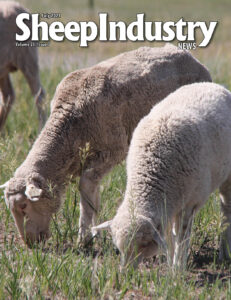JULIE STEPANEK SHIFLETT, PH.D.
Juniper Economic Consulting
Two of the top 20 retailers reported double-digit increases in lamb sales in 2020 and into the first quarter of 2021, according to Midan Marketing for the American Lamb Board in May. Midan reported that a couple of top retailers see “bright opportunity for continued lamb sales,” sparked by a “renewed interest in lamb.”
Dollar sales of American lamb increased 25 percent from 2019 to 2020, and volume sold jumped 18 percent, according to Midan. In December 2020, lamb dollar sales increased 36 percent year-on-year and pounds sold increased 31 percent.
The American lamb industry is segmented by region and targeted consumer group. Midan reported that the Northeast remains the highest-selling region by both dollar and pounds sold, selling more than $140 million of lamb in 2020 (up $25 million from 2019). The Northeast accounts for 30 percent of all sales of lamb (dollars and pounds) in the United States. After the Northeast, the Southeast region is the highest-selling region in the United States and accounts for 16 percent of all dollar sales. New York, Baltimore (Md.)/Washington, D.C., and San Francisco are the top three best-selling metropolitan markets in the country.
If volume and dollar sales increase – which they did in 2020 – then this is a good indictor that lamb demand rose. Expanded demand is likely due to quality, increased diversity of product offering, pent-up income from reduced eating out, and inspiration by younger generations to explore new recipes and proteins.
Retail Lamb Prices: How High is Too High?
If lamb supplies continue to tighten year-on-year, only expanded demand can keep retail prices at current or lower levels.
According to U.S. Department of Agriculture slaughter data, the federally inspected lamb market is contracting, down 11 percent from 2016 to 2020 and down 8 percent from 2019 to 2020. A much smaller lamb market of lighter-weight lambs in state inspected facilities – accounting for about 13 percent of the heavier-lamb, traditional market – is growing, up 28 percent in five years and up 5 percent in 2020. As sheep and lamb inventory contracts nationally (ewe numbers were down 1 percent in 2021), the pull from the growing lighter-weight market will intensify, putting pressure on feeder lamb prices.
In early June, 68,907 head of feeder lambs were reported in Colorado feedlots, down 15 percent monthly and down 29 percent (nearly 28,000 head) from June’s five-year average.
In the first 20 weeks of the year, federally inspected estimated lamb harvest was 755,990 head, up 4 percent year-on-year. Estimated lamb production was 36.1 million lbs., up 2 percent year-on-year. While head count at harvest was higher, live weights slipped 1 percent lower during this period to 132 lbs. It is believed that increasingly federally inspected harvest is capturing lighter-weight lamb sales.
Lighter-weight lambs – typically harvested for ethnic markets – are also being assimilated into more mainstream marketing channels. There are many FI plants that process lambs for the Halal ethnic market, and lambs that would normally go into the traditional market are now going to the ethnic market.
Total lamb imports were down 10 percent in January to April year-on-year to 71.6 million lbs. Australian imports were down 14 percent to 51.1 million lbs. and New Zealand’s imports were up by 2 percent to 19.5 million lbs.
There have been dramatic swings in reported freezer inventories in the last year. By May, freezer inventory was 48 percent lower than its all-time high in June 2020 of 48 million lbs. At 24.7 million lbs., freezer inventory was down 2 percent monthly and 39 percent lower year-on-year. Lamb and mutton in cold storage dipped to its lowest level in May since early 2017. Reduced stocks help to support lamb prices through the marketing chain.
Summer is typically a tight lamb supply period, but it is anticipated that the industry will face a supply squeeze unlike any seen before in coming months, which will raise prices further, and test the resiliency of consumer demand.
Best Performing Lamb Markets
Four markets – San Francisco/Oakland, Baltimore/Washington, D.C., Boston and New York – sell more than twice the amount of lamb per capita relative to the rest of the United States according to Midan Marketing’s Category Development Index in May. This means that promotional efforts in these markets can increase or support lamb recognition.
These top performing markets also have significant ethnic populations. The minority populations – which accounted for 35 percent of America’s population in 2008 – consumed a disproportionate 58 percent of the lamb available, according to Shiflett, Williams and Rodgers in 2010. The study also found that consumers that do not speak English at home consumed an estimated 3.3 lbs. of lamb per person annually at home and 2.4 lbs. of lamb per person annually away from home. By comparison, Americans eat about 1 lb. per person per year.
Live Lamb Hit Record High
At the time this article was written, negotiated lamb prices had reached new record highs surpassing those set in 2011. In May, live, negotiated slaughter lamb prices averaged $202.60 per cwt., up 8 percent monthly, and 24 percent higher than March 2020 (USDA did not report prices last May). The average harvest weight in May was 144 lbs.
In the Western states, feeder lambs averaged $240 to $265 per cwt. for 80 to 95 lbs. lambs in the Western Video Sheep Video/Internet Auction. The report noted that nearly 5,000 head traded for early June through October delivery.
In early June, South Central feeder lambs (Kansas, Missouri, New Mexico, Oklahoma and Texas) averaged $263.75 per cwt. for 85 lbs. according to the Equity Cooperative Sheep & Lamb Video/Internet Auction.
Historically, mostly wooled and shorn lambs sold at the New Holland, Penn., auction, but then the momentum swung toward more light-weight hair sheep and USDA termed the auction “nontraditional.” The pendulum has now swung the other way, with the majority of lambs selling from wooled/shorn breeds. This exerts increased demand on wooled breeds in the West, South Central and Midwest, from traditional feeders (finishing lambs in a feedlot) and ethnic buyers.
In May, 80- to 90-lb. lambs at the auction in New Holland averaged $249.31 per cwt., down 8 percent monthly and up 35 percent from last June (Good & Choice 1-2. USDA did not report prices last May). Ninety- to 110-lb. lambs averaged $241.47 per cwt. in May, down 6 percent monthly. Higher quality lambs in the same weight range brought $290 to $295 per cwt. in May.
Wholesale Rack Tops $11 per Lb.
At wholesale, the rack appeared unstoppable, gaining 39 percent in May from its Covid-low last September. The 8-rib rack medium averaged $1,113.38 per cwt. in May, up 12 percent monthly. The loin, trimmed 4×4, saw $790.49 per cwt., up 10 percent from April. The leg, trotter-off, averaged $501.18 per cwt. in May, up 10 percent monthly. The shoulder, square-cut, averaged $392.25 per cwt., up 8 percent monthly.
Annual gains in primals have been unprecedented. In May, the rack was 30 percent higher annually, the loin rose 65 percent annually, the leg gained 29 percent, and the shoulder was up 18 percent year-on-year. Ground lamb averaged $707.09 per cwt., up 8 percent monthly and up 26 percent year-on-year.
The USDA Agricultural Marketing Service no longer reports a lamb carcass price. However, it reports an estimated national lamb carcass cutout value, which “represents the estimated value of a lamb carcass based on prices paid for individual lamb items,” according to USDA/AMS. The cutout value represents all weights, and a yield percentage that is based upon a 65-lb. carcass. In May, the estimated national lamb carcass cutout value was $531.45 per cwt., up 9 percent monthly and up 29 percent year-on-year. Since February, the monthly lamb carcass cutout value has broken its previous month’s record.
Wool Market Stronger
This spring, domestic buyers (some buying for export) carried the market and provided sufficient competition to support prices at levels that traded a significant amount of wool. Yet, reportedly, a fair amount of wool remains stored on growers’ farms and ranches. Given recent gains in the Australian wool market in early June, there is some sentiment that the fall wool market looks promising.
In early June, renewed buying interest from India and Europe – coupled with continued Chinese support – led to higher Australian Merino and crossbred wool prices according to Sheep Central. While the Australian Eastern Market Indicator regained some of its pre-Covid value, the coarser crossbred fleeces only recently saw an uptick. In general, the price of superfine wool has tripled during the last two years while coarser wools have lost value.
The EMI averaged Australian 1,393 cents per kg (U.S. 489 cents per lb. clean), 4 percent higher monthly, and 19 percent higher year-on-year in early June. The EMI was the highest in 14 months, but remained considerably lower than its 2019 average of Australian 1,742 cents per kg clean. Given the rate of recent price gains, it could about a year before the EMI reaches pre-Covid levels.
Australian wool prices trend very differently by micron, however, with finer wools regaining some of Covid’s losses while coarser wools (25 to 32 micron) only recently saw a small uptick in values. In May, the finer wools saw month-over-month price strengthening while the coarse wools lost value. Eighteen micron averaged $6.92 per lb. clean in May, up 3 percent monthly and 51 percent higher year-on-year. Coarser 30 micron saw $1.46 per lb. clean in May, down 8 percent monthly and down 4 percent from a year ago.
In general, as micron-measuring equipment improved in the early 1990s it became increasingly clear that wool fibers 30 micron and more were less comfortable close to the skin than superfine wools (18.5 micron and lower). As a result, demand for finer wools expanded (and prices rose); demand for coarser wool contracted.





